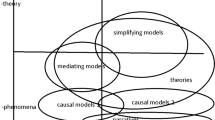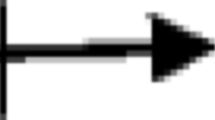Abstract
Scientific explanations arc subject to the occurrence of inconsistencies. To rule them out in many cases demands the construction of new theories. As the examples of complementary explanations show, that may take a while. Furthermore, even if possible in principle, it is not always reasonable to eliminate inconsistencies immediately, e.g., by bringing in a more sophisticated formal language. After all, under some circumstances a provisional, not fully coherent explanation may be better than none. In any case, we need a logically controlled approach to such inconsistencies. Modern logic provides the tools which are necessary to solve this task. We will mention two alternative approaches.
Similar content being viewed by others
REFERENCES
Batens, D.: 1999, ‘Inconsistency-Adaptive Logics’, in E. Orlowska (ed.), Logic at Work. Essays Dedicated to the Memory of Helena Rasiowa, Physica Verlag, Heidelberg.
Clausius, R.: 1898, ‘Ñber die bewegende Kraft der Wärme und die Gesetze welche sich daraus für die Wärmelehre selbst ableiten lassen’, reprinted in M. Planck (ed.), Ñber die bewegende Kraft der Wärme und die Gesetze welche sich daraus für die Wärmelehre selbst ableiten lassen, Verlag von Wilhelm Engelmann, Leipzig, pp. 1–52.
Frankel, E.: 1950, Preface to Aeschylus: Agamemnon, Oxford University Press, Oxford.
Heisenberg, W.: 1989, Physics and Philosophy, Penguin Books, New York.
Jacquette, D.: 1992, ‘Contradiction’, Phil. Rhet. 25, 365–90.
Jaskowski, S.: 1948, ‘Rachunek zdan dla systemow dedukcyjnych sprzecznych’, Studia Societatis Scientiarum Torunensis 1, Section A, 57–77.
Jaskowski, S.: 1969, ‘Propositional Calculus for Contradictory Deductive Systems’, Studia Logica 24, 143–60.
Meheus, J.: 1993, ‘Adaptive Logic in Scientific Discovery: The Case of Clausius’, Logique and Analyse 143–4, 359–91.
Oppenheimer, J. R.: 1958, Wissenschaft und allgemeines Denken, Rowohlt, Hamburg.
Reichenbach, H.: 1930, ‘Atom und Kosmos. Das physikalische Weltbild der Gegenwart’, Deutsche Buch-Gemeinschaft, Berlin.
Schurz, G.: 1998, ‘Koexistenzweisen rivalisierender Paradigmen. Eine begriffsklärende und problemtypologisierende Studie’, in G. Schurz, P. Weingartner (Hrsg.), Koexistenz rivalisierender Paradigmen, Westdeutscher Verlag, pp. 1–51.
Smith, J. M.: 1988, ‘Inconsistency and Scientific Reasoning’, Studies in History and Philosophy of Science 19, 429–45.
Urchs, M. P.: 1995, ‘Handling Inconsistent Information. Towards a Logic of Rational Discourse’, in I. Max and W. Stelzner (eds.), Logic and Mathematics. Frege-Colloquium 1993, Perspectives in Analytical Philosophy, de Gruyter, Berlin, New York, pp. 369–84.
Wigner, E. P.: 1960, ‘The Unreasonable Effectiveness of Mathematics in the Natural Sciences’, Communications on Pure and Applied Mathematics 13, 1–14.
Author information
Authors and Affiliations
Rights and permissions
About this article
Cite this article
Urchs, M. Complementary Explanations. Synthese 120, 137–149 (1999). https://doi.org/10.1023/A:1005270806908
Issue Date:
DOI: https://doi.org/10.1023/A:1005270806908




